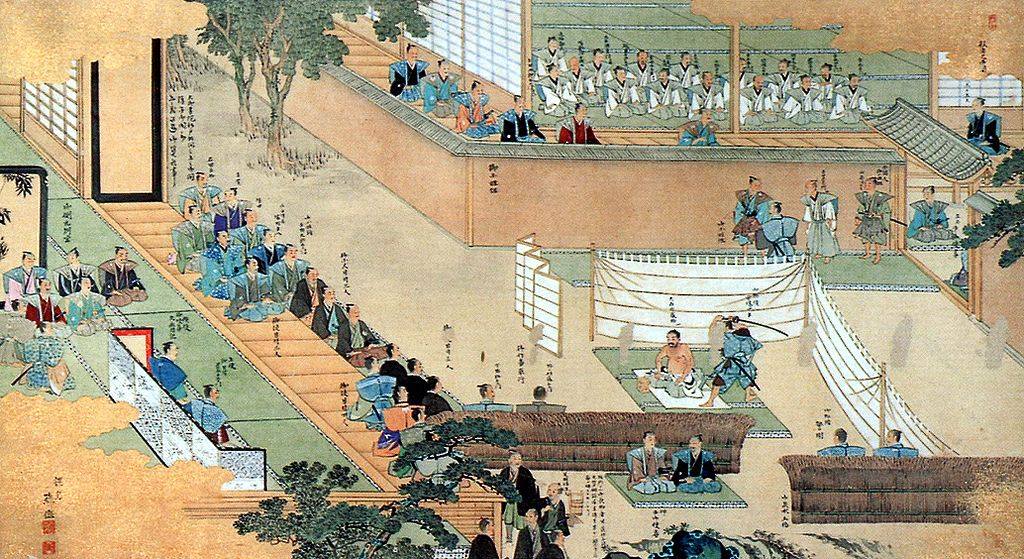The 47 Ronin, Warriors of Ako, committed seppuku on this day, March 20.
The story began in 1701, when the Lord of Ako, Asano Nagamori, attacked the Chief of Protocol, Lord Kira within the grounds of Edo Castle, for which he was ordered to commit seppuku. Asano’s lands at Ako (now part of Hyogo Prefecture) were confiscated, and his over 300 samurai were forced to disband.
On the night of Tuesday, January 30, 1703, (14th day of the 12th month by the old Japanese calendar, and the date by which the event is still remembered in Japan) 47 of the former men of Ako stormed the mansion of Kira Yoshinaka, killing the 62-year-old Chief of Protocol.
Having cut off the man’s head, they carried it about 14 km through the streets of Edo to the grave of their former master, Lord Asano, at the Sengaku-ji, a temple in the southern districts of Edo. Then having paid their respects before the grave, they turned themselves in to the authorities.
Although they defied orders prohibiting revenge, they had exemplified the way of the samurai. The Shogunate spent weeks discussing the pros and cons of their actions, before deciding to allow them to commit seppuku rather than be executed.
According to the story, they committed seppuku in the grounds of the Sengaku-ji Temple upon completion of their task.
In fact, the 46 men were separated and billeted out to the homes of various daimyo in Edo at the time while the Bakufu decided upon their fate.
Oishi Kuranosuke, leader of the 47 Ronin, and 16 of the Ronin were sent to Lord of Higo, (Kumamoto) Hosokawa Tatsunari’s mansion, located in modern day Minato-ku of Tokyo. A monument and the site of the mass seppuku has been preserved.
Oishi’s son was confined to the home of Matsudaira Sadanao, and the two had been allowed to meet on the evening prior to their deaths. On February 3, 1703, the Bakufu had issued orders that the men, being held in various daimyo homes, were to commit seppuku the following day. Four locations around Edo were decided on, and hastily prepared for the following days actions. Accepting the sentences as an honor, on Tuesday, March 20th, 1703, they performed the seppuku rituals.
Once the men had redeemed themselves through self-destruction, their decapitated bodies were folded into a fetal position, with their heads placed on their knees inside a round wooden tub-like coffin, and carried to the Sengaku-ji where they were buried.
On the gravestones of all the ronon is the kanji for “yaiba”, written刃 except for one, the ashigaru class foot soldier, Terasaka Kichiemon Nobuyuki, the 刃 kanji does not appear on his stone.
Terasaka was an ashigaru to the Ronin Yoshida clan. At the time of the attack, Terasaka was sent by Oishi Kuranosuke to inform the remaining Asano clan, including Lord Asano’s widow in modern-day Hyogo Prefecture, that the band of 47 Ronin had sought revenge on the death of their master. Because of his actions, he was pardoned by the shogun. There are claims that he was pardoned because of his young age, however, Oishi Kuranosuke’s son was at 14 or 15, even younger than Terasaka. It is probable that his rank, as ashigaru, did not include him having to commit seppuku.
Terasaka died 43 years after the incident aged 83. (some sources list 78, however a letter by his grandson survives in Kochi city confirming his grandfather’s age) He was later buried alongside his comrades in arms, however the kanji 刃 does not appear on his gravestone. He is reported to have become a Buddhist priest, serving at the Sengaku-ji and tending to the graves of his comrades following the incident.
Source: Facebook

